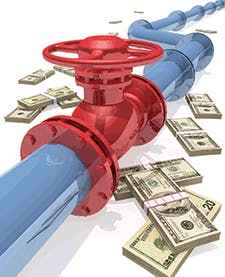Energy is increasingly a supply chain issue. Energy use, energy cost, energy conservation and the consequences of energy use (emissions, etc.) reach into every part of the supply chain. While warehouse and distribution center operators may focus much of their attention on what happens within the four walls of their facility, they should also be looking at the bigger picture—including the place that facility occupies in their logistics network.
Inside the warehouse, 60% of the cost is labor, says Tim Feemster, managing principal of Foremost Quality Logistics. He strongly encourages distribution center operators to pursue energy-saving strategies, starting with lighting, because the savings are real and substantial. But, with so much cost tied up in labor, he points out that some of those same decisions can improve efficiency. Switching to hydrogen-fueled lift trucks, for instance, can reduce labor cost because it takes just about two minutes to refuel a hydrogen lift truck instead of 30 minutes to change a battery on an electric lift truck, he points out.
Feemster points to distribution center energy consumption, noting it includes lighting, heating, cooling and power for processing automation. As more companies look at addressing labor cost and availability issues by increasing the use of automation, this increased automation leads to increased energy consumption. Some of that increase can be mitigated by reducing costs and use in some of the other areas.
Feemster points to lighting as one of the first steps. At one major third-party logistics service company, Feemster says, he looked at energy audits, and if they didn't have either T5 or T8 lighting, the site was crossed off the list. Now, he looks for LED lighting which not only is efficient but doesn't produce heat, which can be important in refrigerated facilities.
Big Picture View
Network optimization is critical to the supply chain for both cost and service reasons. The dynamics of locating distribution centers are changing, notes David Closs, chair of the Supply Chain Management Department at Michigan State University. Closs told a group at a Port Lansing trade conference that even recently, using modeling tools, you would make a selection and put a distribution center in a location where it would probably last five years. In today's environment, that decision probably lasts three months because of transportation rate changes, risk changes, opportunity changes and market changes. You have to look at it much more often, he says—though he suggests close monitoring and periodic adjustments along the way, not totally revamping the network every few months.
Chicago Consulting poses the rhetorical question, "Do you have too many warehouses?" The only real service benefit to having multiple regional warehouses with the same mission carrying the same products, says a report, is to get closer to customers and reduce the time it takes them to get your products. Multiple warehouses cost more, the group continues. They duplicate certain fixed costs and increase the amount of inventory. And, if the goal is to reduce lead times to improve customer service, the group suggests, "When you locate warehouses unwisely, they might not reduce lead times at all."
Patrick Sedlak, principal of Sedlak Management Consultants, takes up the argument and offers the case of a retail client whose distribution network handles 2 billion units in the course of a year. They were able to realize a $50 million savings by leveraging the size and mix of distribution facilities in that network. Transportation expense drives the model, he points out, comprising over two-thirds of the total.
Transportation is clearly an energy-intensive element in the supply chain. In U.S. logistics spending, Rosalyn Wilson, author of the State of Logistics Report, places transportation spending at $852 billion in 2013, the latest year for which figures were available. That is over 60% of the total logistics spending for the year and an increase of 2% over 2012. Even though crude oil prices had dropped below $50 per barrel and appeared to be hovering in that region, price volatility is a constant concern when it comes to fuel.
The escalation of political tensions in the Ukraine and what at presstime was a developing civil war in Yemen have markets nervous. Even without actual disruptions to crude oil supplies or natural gas flows, speculation over a reduction or loss of production or refining capacity can fuel price volatility. With crude oil prices in the $50 range, geopolitical and other drivers pushed prices to the $55 range. A $5-per-barrel rise may not sound like much in the wake of $150-per-barrel prices within the last couple of years, but it is a 10% increase in raw material cost for the refiners.
Feemster reiterates the 60% figure for transportation cost to supply chains and adds that the non-labor costs for the warehouse or distribution center are 3% to 5% of supply chain costs in most environments. He takes the discussion further, suggesting use of multimodal transportation can save 60% on carbon footprint. Being close to rail service, then, is not only part of a transportation strategy, it can be an important component in sustainability plans and, consequently, an element of supply chain network design.
Looking at energy cost relative to transportation, Closs points out that many supply chains were designed with diesel fuel costs of $1.50 to $2 per gallon. If you look at your supply chain with $3 to $4 diesel, he continues, it looks different. If you look at it with $5 or $6 diesel, it looks considerably different.
Some network models favor economies of scale for the facilities, which means fewer, larger facilities, Closs notes. The tradeoff is transportation cost. The more you centralize, the more transportation costs go up. If you add inbound transportation from the source along with the outbound shipping, the numbers favor less centralization.
It used to be simple, says Closs. In the 1990s, you looked at where the demand was and where the raw materials were coming from and you figured out your transportation costs. Now, the issues go beyond just the cost and include sustainability, energy, labor, political and taxation.
Feemster puts the transportation discussion in context with a multimodal example. Shifting the long-haul portion of the move to rail intermodal offers a more environmentally-friendly choice. Typically, rail intermodal will be less expensive than the comparable truckload service. But, returning to the location discussion, Feemster points out the importance of proximity to transportation. For a 100,000 square-foot facility handling 2,000 marine containers per year, a difference between being three miles from the rail intermodal ramp and being 30 miles away can be $100 in drayage charges per trip. For the example's 2,000 containers, that spells $200,000 in annual transportation costs. When you roll that drayage cost into the operating costs of the facility, it adds $2 per square foot to the facility costs.
Fueling Change
In a closed session with legislators, a group of motor carriers discussed their experience with alternative fuels. From both a cost and emissions standpoint, the motor carriers supported alternative fuels, but widespread adoption faces some barriers.
From the operations perspective, the carriers pointed out that refueling with compressed natural gas (CNG) or liquefied natural gas (LNG) can't take longer than the comparable operation with diesel fuel. If it takes 15 to 17 minutes for a driver to refuel from a diesel pump, the carriers would like to see parity with the alternative fuels—in other words, no longer than 15 to 20 minutes to refuel at a CNG station.
Adding a CNG or LNG fueling station to an existing facility can be costly. One carrier noted that it can add $75,000 to make the alternative fuelling station compliant by the time the warning systems, special heating systems and other components are added. A private fleet operator with a substantial portion of its fleet converted to CNG points out that the cost was averaging $250,000 per facility, depending on the size and age of the facility.
One of the issues that will need to be addressed in order to take alternative-fuel vehicles beyond local/regional operations is the infrastructure. Some public sector operations such as transit authorities are operating CNG-fueling stations for their vehicle fleet and may also operate a public pumping station where motor carriers have been able to fuel their vehicles. However, a commercial network of fueling stations is also needed, and that will take time and a significant investment. Here, the carriers strongly suggest encouraging investment through public policy initiatives.
Government initiatives clearly need to encourage infrastructure development, but carriers add another concern. Moving to LNG/CNG sacrifices about 2,500 pounds of payload per vehicle, the carriers point out. With a gross vehicle weight limit of 80,000 pounds, that's a 3% capacity loss. Some states have passed allowances for CNG/LNG vehicles, but the carriers note, this creates "islands" and makes network planning very complex.
Tax incentives for conversion to alternative fuels are clearly a plus, but the incentives expire. If the carriers knew the incentives would last for three to five years, it would be easier to make the kind of financial and operational commitment to proceed, they note. But if the incentives are only put in place year to year, the carriers say they can't factor that into a larger, multi-year equipment strategy where they also have to account for new engine standards for their core diesel fleet.
And while they are on the tax discussion, the carriers note the alternative fuel tax system has not been adapted well to the diesel environment. There is a gasoline-gallon conversion, but motor carriers operate in a diesel environment and note there should be a diesel-gallon equivalent conversion standard. In this area, too, there are islands as some states are developing conversion rates based on energy content.
Developing an energy or sustainability strategy for a supply chain is clearly a juggling act that challenges distribution executives to balance what they do inside a facility against where that facility is located, its size, its degree of automation, and its interaction with a complex transportation network. More options are developing that will enable supply chains to improve both cost and environmental impact.
Perry A. Trunick is a supply chain industry journalist and consultant with 35 years of experience. He is also a member of the adjunct faculty of the Operations and Supply Management Department of the Monte Ahuja School of Business at Cleveland State University.




